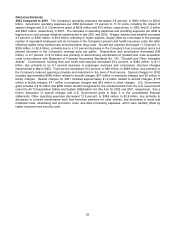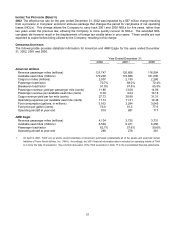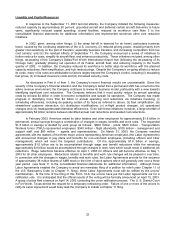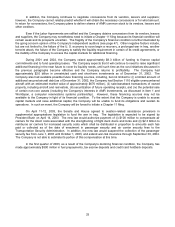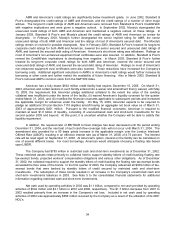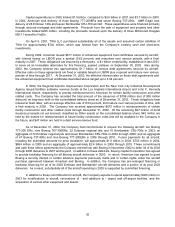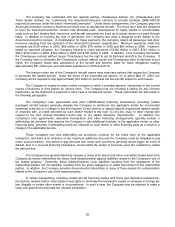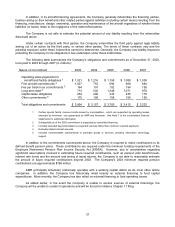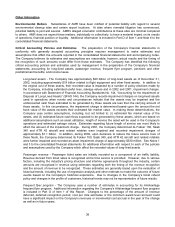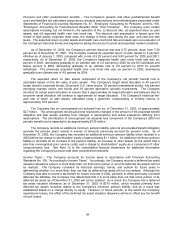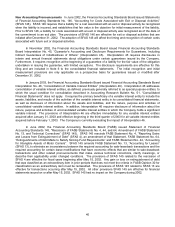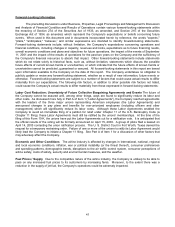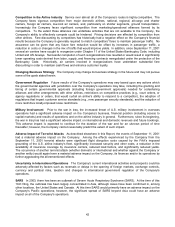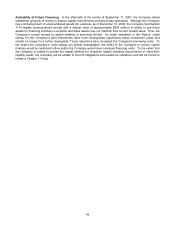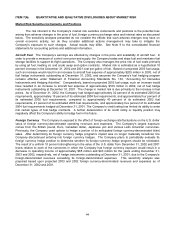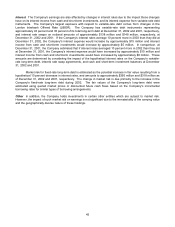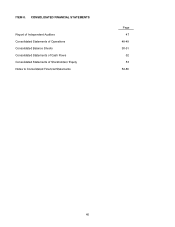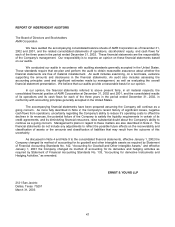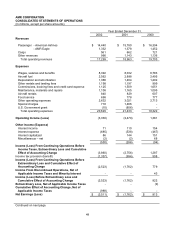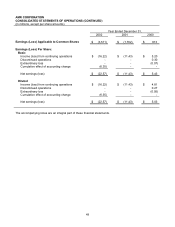American Airlines 2002 Annual Report Download - page 41
Download and view the complete annual report
Please find page 41 of the 2002 American Airlines annual report below. You can navigate through the pages in the report by either clicking on the pages listed below, or by using the keyword search tool below to find specific information within the annual report.39
Pensions and other postretirement benefits – The Company’s pension and other postretirement benefit
costs and liabilities are calculated using various actuarial assumptions and methodologies prescribed under
Statements of Financial Accounting Standards No. 87, “Employers’ Accounting for Pensions” and No. 106,
“Employers’ Accounting for Postretirement Benefits Other Than Pensions”. The Company uses certain
assumptions including, but not limited to, the selection of the: (i) discount rate, (ii) expected return on plan
assets, and (iii) expected health care cost trend rate. The discount rate assumption is based upon the
review of high quality corporate bond rates, the change in these rates during the year, and year-end rate
levels. The expected return on plan assets and health care cost trend rate are based upon an evaluation of
the Company's historical trends and experience taking into account current and expected market conditions.
As of December 31, 2002, the Company’s pension discount rate was 6.75 percent, down from 7.50
percent as of December 31, 2001. The Company lowered its expected return on plan assets to 9 percent,
effective as of January 1, 2003, compared with a rate of 9.25 percent and 9.50 percent for 2002 and 2001,
respectively. As of December 31, 2002, the Company’s expected health care costs trend rate was six
percent in 2003, decreasing gradually to an ultimate rate of 4.5 percent by 2005 for pre-65 individuals and
twelve percent in 2003, decreasing gradually to an ultimate rate of 4.5 percent by 2010 for post-65
individuals. The previously assumed health care cost trend rate was six percent in 2002, decreasing
gradually to an ultimate rate of 4.5 percent by 2004.
The expected return on plan assets component of the Company’s net periodic benefit cost is
calculated based on the fair value of plan assets. The Company’s target asset allocation is 40 percent
longer duration corporate bonds, 25 percent U.S. value stocks, 20 percent international stocks, five percent
emerging markets stocks and bonds and 10 percent alternative (private) investments. The Company
monitors its actual asset allocation to ensure that it approximates its target allocation and believes that its
long-term asset allocation will continue to approximate its target allocation. The Company’s historical ten-
year rate of return on plan assets, calculated using a geometric compounding of monthly returns, is
approximately 10.5 percent.
The Company has an unrecognized net actuarial loss as, of December 31, 2002, of approximately
$2.7 billion. The unrecognized net actuarial loss represents changes in the amount of the projected benefit
obligation and plan assets resulting from changes in assumptions and actual experience differing from
assumptions. The amortization of unrecognized net actuarial loss component of the Company’s 2003 net
periodic benefit cost is expected to be approximately $130 million.
The Company records an additional minimum pension liability when its accumulated benefit obligation
exceeds the pension plans’ assets in excess of amounts previously accrued for pension costs. As of
December 31, 2002, the Company has recorded an additional minimum pension liability which resulted in a
2002 before tax charge to stockholders’ equity of approximately $1.1 billion. An additional minimum pension
liability is recorded as an increase to the pension liability, an increase to other assets (to the extent that a
plan has unrecognized prior service costs) and a charge to stockholders’ equity as a component of other
comprehensive loss. See Note 12 to the consolidated financial statements for additional information
regarding the Company's pension and other postretirement benefits.
Income Taxes – The Company accounts for income taxes in accordance with Financial Accounting
Standards No. 109, “Accounting for Income Taxes”. Accordingly, the Company records a deferred tax asset
valuation allowance when it is more likely than not that some portion or all of its deferred tax assets will not
be realized. The Company considers its historical earnings, trends, and outlook for future years in
determining whether it is more likely than not that its deferred tax asset will not be realized. Although the
Company was able to record a tax benefit for losses incurred in 2002, primarily to offset previously recorded
deferred tax liabilities, the Company has determined that it is more likely than not that some portion of its
deferred tax asset as of December 31, 2002 will not be realized. As a result, the Company has a deferred
tax asset valuation allowance as of December 31, 2002 of $370 million, which resulted primarily from
deferred tax assets recorded related to the Company’s minimum pension liability, and as a result was
established based on a charge directly to equity. However, in future periods, to the extent the Company
experiences losses, the effect of the deferred tax asset valuation allowance will be to offset any tax benefit
of such losses.


